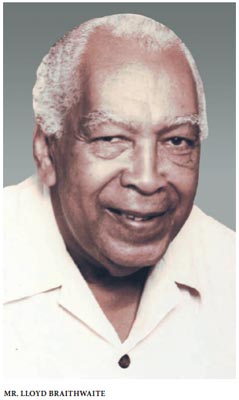|
August 2012

Issue Home >>
|

 The Student Administration Building is to be named after Lloyd Braithwaite (1919-1995), who served as Principal at St Augustine between 1969 and 1984. A Trinidadian born to a distinguished Belmont family, Braithwaite was an outstanding sociologist who devoted his life to scholarship and to the regional University. The Student Administration Building is to be named after Lloyd Braithwaite (1919-1995), who served as Principal at St Augustine between 1969 and 1984. A Trinidadian born to a distinguished Belmont family, Braithwaite was an outstanding sociologist who devoted his life to scholarship and to the regional University.
As a young man, Braithwaite became involved in the radical and anti-colonial politics of the Trinidad of the late 1930s and 1940s. When still at school (Queen’s Royal College) he helped organize demonstrations against Italian businesses after the 1935 invasion of Ethiopia, and in the early 1940s he was a founder of the Why Not? group of young, radical intellectuals.
He qualified as a solicitor, but his deep interest in social issues and his concern for the ordinary people brought him to the notice of the Social Welfare Advisor, a British sociologist called Dora Ibbertson, and earned him a scholarship to the London School of Economics just after World War II. He could have stayed to do his PhD, but left with a BA in Sociology to take up a research fellowship at the Institute of Social and Economic Research (ISER) of the new UCWI at Mona, Jamaica.
Braithwaite remained at Mona for nearly 20, doing pioneering research—his famous Social Stratification in Trinidad comes out of this period—and establishing the academic discipline of sociology at the new University. When the Faculty of Social Sciences was created, he left ISER and became senior lecturer, then Professor, of Sociology. As one of the few senior West Indian academics in that Faculty, he was also drafted to serve as Dean.
When a new Principal was needed at St Augustine in 1969, Braithwaite was prevailed on to accept the post. Perhaps he was ill-suited to be a full-time administrator, and he told everyone that he had never wanted the post. He accepted it, and held it until 1984, out of a selfless sense of duty.
A man of absolute integrity who lacked any sense of self-interest, he refused to allow university funds to be spent on renovating the Principal’s house so long as he occupied it. Famously, visits to the Principal’s office almost always found him immersed in the latest scholarly work on the Caribbean—instead of the files and the memos he probably should have been reading or writing.
But if Braithwaite was not the most efficient of university administrators, as Principal he was well-informed, tolerant, balanced in his views, and humane. Sympathetic and approachable, his leftist past and his liberal instincts ensured that he could always appreciate the positions of the ‘other side’, such as the radical student leaders of 1969-70. Even when they adopted tactics he couldn’t approve, and was often the victim of (such as the occasion in 1980 when a large crowd of students besieged him in his office and threw furniture and files around), Braithwaite remained calm, rational and good-humoured. It was surely an advantage to the Campus, during a generally turbulent period, to have a leader who was politically and intellectually independent and, above all, scholarly.
Braithwaite was a path-breaking scholar, an inspiring teacher, and an instinctive mentor. Many former students have testified to learning far more than sociology from him. He did much of his real teaching and mentoring away from the formal classroom, during the endless impromptu seminars, interviews, chats and limes which he conducted—before, during and after his term as Principal. This is why it is wholly appropriate to name a building dedicated to serving students after Lloyd Braithwaite.
Bridget Brereton is Emerita Professor of History and author of the 2010 “From Imperial College to The University of the West Indies.” This is the final of her series of articles giving the background to the eight buildings that have been named after members of the university community. |





